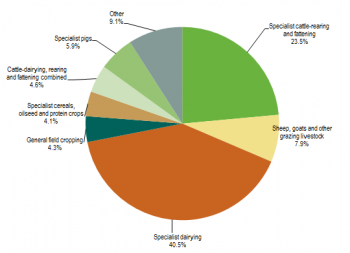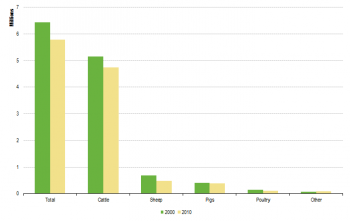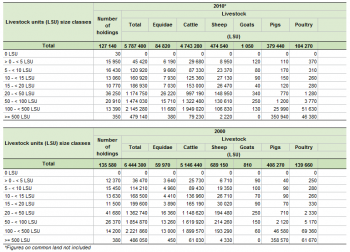Archive:Agricultural census in Ireland
This article has been archived.
This article is part of a series of country-specific essays on the results of the European Union (EU) Farm structure survey (FSS) 2010. The FSS collects information on the structural characteristics of agricultural holdings (land use, livestock and labour force) and is carried out by all European Union Member States every 10 years as an Agricultural census, with two or three additional, intermediate sample surveys carried out in-between.
The present analysis of farm structure includes a comparison with the Agricultural census 2000. In contrast with the FSS 2010, the Agricultural census 2000 in Ireland did not include information on common land. As a result, in order to allow comparison between the two reference years, 2010 data presented throughout this article do not include information on common land when the analysis refers to the two waves of the survey. On the other hand, data on common land are taken into account when the analysis concerns only the most recent data set.

Source: Eurostat (ef_kvaareg) (ef_ov_kvaa) (demo_pjan) and FSS 2000 and 2010
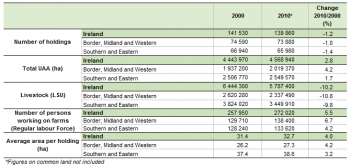
Source: Eurostat (ef_kvaareg) (ef_ov_kvaa) and FSS 2000 and 2010

Source: Eurostat (ef_kvaareg) (ef_ov_kvaa)

Source: Eurostat (ef_kvftreg)
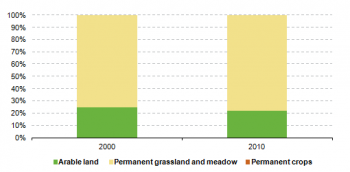
Source: Eurostat (ef_lu_ovcropaa) (ef_oluaareg)
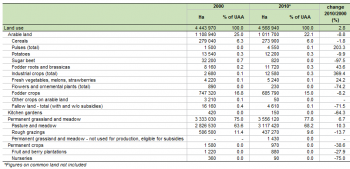
Special value: "-" not available
Source: Eurostat (ef_lu_ovcropaa) (ef_oluaareg)
Source: Eurostat (ef_mptenure)

Source: Source: Eurostat (ef_pmhouscatlaa)
Main statistical findings
Key indicators
As shownin Table 1, there were about 140 000 agricultural holdings in Ireland in 2010. The Irish population of farms remained fairly stable, a noteable exception among the survey countries: it only decreased by 1.2 % over the decade 2000-2010 (- 1 670).
In addition, Irish utilised agricultural area (UAA) also remained quite stable over the years under analysis: it only increased by 2.8 %, to about 4.6 million hectares in 2010 compared with 4.4 million hectares in 2000. Taking into account common land, this rises to 5.0 million ha. The ratio between agricultural land and the total area of Ireland was the highest within the EU-27: the UAA in Ireland covered 71.5 % of the whole territory in 2010.
With the number of holdings slightly decreasing and the agricultural area increasing, the average size of the holdings increased, from 31.4 ha per farm in 2000 to 32.7 ha in 2010.
In contrast to the decreasing numbers of persons employed in agriculture observed in many EU Member States, the number of persons regularly working on farms in Ireland increased over the decade (+ 5.5 %), from 257 950 to 272 020. The agricultural labour force represented 12.5 % of the active population[1] in 2010.
According to the FSS 2010, there were 5.8 million livestock units (LSU) in Ireland, – compared with 6.4 million LSU in 2000 (- 10.2 %). This means that there are 1.30 LSU/person in Ireland, by far the highest ratio in the EU-27.
Regional key indicators
The regional analysis presented in Table 2 shows a very even distribution of resources between the two Irish NUTS 2 regions: “Border, Midland and Western” and “Southern and Eastern”. While “Border, Midland and Western” accounted for a slightly higher share of holdings (53 %), “Southern and Eastern” recorded a larger agricultural area (2.6 million ha) and accounted for 56 % of the Irish UAA in 2010.
The agricultural labour force was also evenly distributed: 51 % of the persons regularly working on farms were recorded in “Border, Midland and Western” and 49 % in “Southern and Eastern”.
In terms of livestock, “Southern and Eastern” accounted for a larger share of the population of farm animals (60 %) than “Border, Midland and Western” (40 %).
As the “Border, Midland and Western” region only accounts for about a quarter of the total Irish population, these numbers lead to the conclusion that agriculture is more prevalent in this region than in the “Southern and Eastern” region.
Agricultural holdings
In Ireland, two thirds of the holdings have between 10 and 49.9 hectares of agricultural area in 2010. These holdings accounted for 46 % of the total Irish UAA.
The number of holdings with no land was marginal (130). In addition, farms with less than 10 hectares of agricultural land (25 340) accounted for only 3 % of the Irish agricultural area and represented 18 % of the country’s population of farms. On the other hand, farms with 50 to 99.9 hectares of agricultural area (20 760) accounted for 15 % of the Irish population of holdings and covered 28 % of the country’s UAA (1 389 390 ha) while farms with at least 100 hectares of UAA represented 3 % of the population and 23 % of the UAA.
See detailed data at NUTS 2 level for 2010 and 2000
Economic size of the farm
As shown in Table 3, the total economic size of all Irish farms was EUR 4 279 million in 2010. This value, which is calculated by summing up the standard outputs (SO) per hectare of crop and per head of livestock of the farms, fell by 6 % compared with 2007 (EUR 4 570 million). Compared with the FSS 2007, farms with less than EUR 15 000 of SO increased their importance: in particular, holdings with less than EUR 2 000 of standard output recorded the highest increase (+74 %). The medium size classes between EUR 15 000 and EUR 99 999 all reported decreases, while a large rise was observed for farms with an economic size of EUR 250 000 to 499 999 SO (+ 46 %). In contrast, holdings with an economic size of EUR 500 000 or more recorded the biggest decrease (- 24 %).
In terms of the standard output of the farm, resources appeared to be distributed unevenly between the Irish regions. “Southern and Eastern” played the major role, with 65 % of the country’s SO, while “Border, Midland and Western” had 35 %.
See detailed data at NUTS 2 level for 2010 and 2007
Agricultural holding by main type of farming
If the number of holdings and the main type of farming are taken into account, Irish agriculture appears to be mainly focused on cattle-rearing and fattening. In 2010, farms specialised in this activity represented 55.6 % of the whole population of holdings. In addition, agricultural holdings dedicated to sheep, goats and other grazing livestock accounted for 18.4 %; farms specialised in dairying recorded the only other double digit share (11.2 %).
As shown in Figure 3, the ranking looks different in terms of the economic size: agricultural holdings specialised in dairying were the most important (40.5 %) in 2010. Agricultural holdings dedicated to cattle-rearing and fattening accounted for 23.5 % and those specialised in sheep, goats and other grazing livestock for 7.9 %. More than two thirds of Irish agricultural economic output is therefore generated through cattle farming.
See detailed data at NUTS 2 level for 2010
Land use
The Utilised Agricultural Area (UAA) is the total area used by a farm, regardless of the type of tenure or whether it is used as a part of common land. Generally, it includes four major components: arable land, permanent grassland and meadow, permanent crops and kitchen gardens. In Ireland, UAA is essentially taken up by arable land and permanent grass land and meadows.
As shown in Table 4, arable land accounted for 22.1 % of the total agricultural area in 2010, and permanent grassland and meadow for 77.8 %, a distribution that is in line with the high prevalence of cattle farming established above. Arable land in Ireland actually decreased over the inter-census decade (-8.8 %); in contrast, the area of permanent grassland and meadow rose (+6.7 %), from 3.3 million hectares to 3.5 million ha.
See detailed data at NUTS 2 level for 2010 and 2000
Arable land
In 2010, Irish arable land was essentially used for the cultivation of fodder crops (68 %) and cereals (27 %); it covered an area of 1 million hectares. Compared to the FSS 2000, arable land decreased by about 100 000 hectares (-8.8 %), fodder crops decreased by 8.2 % (- 61 530 ha), while the share of cereals dropped by 1.8 % (-5 140 ha). The cultivation of sugar beets almost ceased completely, dropping from 32 200 ha in 2000 to 820 ha in 2010.
See detailed data at NUTS 2 level for 2010 and 2000
Permanent grassland
In Ireland, permanent grassland is of great importance and represents by far the main component of the UAA. In 2010 it covered 77.8 % of the agricultural area of the country (3.5 million ha), while in 2000 it took up 3.3 million hectares and accounted for 75 % of the country’s agricultural land. Irish permanent grassland comprises mainly of pasture and meadow, which in 2010 covered an area of 3.1 million hectares and accounted for 68.2 % of the country’s UAA: an increase of 290 890 hectares (+10.3 %) compared with 2000; and 437 270 hectares rough grazings, accounting for 9.6 % of the Irish UAA.
See detailed data at NUTS 2 level for 2010 and 2000
Livestock
Statistics on livestock use two different units of measurement: the number of head (number of animals) and the livestock unit (LSU) – the latter allows comparison between different types of livestock by assigning different coefficients based on feeding requirements to each type of animal.
According to the Agricultural Census 2010, there were about 5.8 million LSU in Ireland, a decrease (- 10 %) compared with 2000 (6.4 million LSU). In relative terms, there were 1.3 LSU per inhabitant in 2010, the highest value within the EU-27. An even higher value was recorded in 2000 (1.7): the Irish population increased (+18.3%) while livestock numbers decreased (-10.2 %) over the inter census period.
In Ireland, cattle were by far the most important livestock: they represented 82 % of the population of farm animals and accounted for 4.7 million LSU in 2010. Compared with 2000, the cattle population decreased by about 400 000 LSU (-7.8 %). Accounting for 8.8 % of Irish livestock (474 540 LSU), sheep were the second most important type of farm animal – over the period under analysis their number decreased by 31.1 % (- 214 610 LSU). Pigs accounted for only a minor share (6.6 %) in 2010, compared with the other survey countries, and their number decreased (-7.1 %) compared to the FSS 2000.
In line with the trend in most EU Member States, the decrease in the number of holdings with livestock (- 6.2 %) was sharper than the fall in the number of farms (- 1.2 %) in Ireland. As a result, over the decade 2000-2010, the share of the number of holdings with livestock in the total population of farms decreased, from 96 % to 91 %, although was still one of the highest shares recorded within the EU-27.
The “Southern and Eastern” region recorded the highest number of livestock (3.4 million LSU) and accounted for about 60 % of the entire population of animal farms in 2010 – the same share as in 2000. The remaining 40 %, corresponding to 2.3 million LSU, was registered in “Border, Midland and Western”.
See detailed data at Nuts 2 level for 2010 and 2000
Labour force
In Ireland, 272 020 people were regularly working on farms in 2010. In contrast with the tendency observed in many EU Member States, this was an increase (+5.5 %) compared with 2000, when 257 950 people were employed in the agricultural sector. If the annual work unit (AWU) is taken into account, the agricultural labour force remained nearly stable at 163 900 AWU in 2000 and 162 350 AWU in 2010 (- 1 %). When analysing these numbers, it is important to keep in mind that Ireland experienced a noteable population increase of 18 % during the inter-census decade.
As mentioned earlier, the agricultural labour force was evenly distributed over the Irish territory. The region “Border, Midland and Western” accounted for 51 % of regular farm employees – the corresponding value in 2000 was 50.3 % – while “Southern and Eastern” Ireland accounted for 49.1 % (49.7 % in 2000).
The share of female holders increased during the period, rising from 15 100 (10.7 %) in 2000 to 17 350 (12.4 %) in 2010.
See detailed data at NUTS 2 level on holders' age and gender for 2010 and 2000
See detailed data at NUTS 2 level on type of labour force for 2010 and 2000
Management practices
Type of tenure
In 2010, three quarters of the Irish agricultural area (3.8 million ha) were farmed by the people who actually owned that land. On the other hand, 784 380 hectares of UAA (15.7 %) were farmed by tenants (see Table 7).
The remaining 422 410 ha (8.5 %) of the agricultural area was common land, a characteristic most prevalent in the “Border, Midland and Western” region.
Animal housing
According to the FSS 2010, there were 111 000 holdings farming 6.6 million head of cattle in Ireland. Accordingly, Ireland had one of the highest populations of farms with cattle within the EU-27.
As shown in Table 8, no single type of animal housing dominated the others. If the number of holdings is taken into account, the most common type of animal housing was that where animals are loose with solid dung and manure (45 320 holdings). In terms of the number of places, the most common type of animal housing was that where cattle are housed loosely with slurry storage incorporated (2.1 million places).
It must be noted that holdings were allowed to report more than one type of housing, which means that the sum of the subcategories in Table 8 does not add up to the total.
Other gainful activities
In Ireland, there were 12 880 farms with an extra source of income (‘other gainful activity’) in 2010, 9.2 % of the total population of holdings, which was among the highest within the EU-27.
Information on other gainful activities was collected by eleven activity categories – each holding could register more than one activity. Forestry work (5 110 farms) was found to be the most common activity other than farm work, followed by contractual work (3 480 holdings) – which could take the form of contractual agricultural work (2 580 farms) and contractual non-agricultural work (1 130 farms). Tourism was also quite important for Irish farms with 1 600 holdings recording it as a gainful activity.
See detailed data at NUTS 2 level for 2000
Organic farming
Organic agriculture is an ecological production management system that promotes and enhances biodiversity, biological cycles, and soil biological activity. It is based on the minimal use of off-farm inputs and on management practices that restore, maintain or enhance ecological harmony.
In Ireland, the UAA under organic farming increased since 2003 and covered an area of 24 850 hectares in 2010 (see Table 10). Nevertheless, it only covered 0.5 % of the Irish agricultural area.
See detailed data at Nuts 2 level for 2010, 2007, 2005, 2003 and 2000
Data sources and availability
Methodological notes
In Ireland, the Farm Structure Survey 2010 was carried out as a census and in accordance with the EU Regulation 1166/2008. The first Irish Agricultural Census was conducted in 1847; since 1980 the census has been carried out every ten years – the responsible body is the Agricultural Division of the Central Statistics Office (CSO).
Survey on agricultural production methods (SAPM)
In 2010 a unique survey was carried out together with the Agricultural census, the Survey on agricultural productions methods (SAPM). This survey collected data at regional level needed to establish agri-environmental indicators as indicated in COM final 508/2006 and to evaluate the greening of the Common Agricultural Policy.
Data were collected according to the specifications listed in Annex V of the regulation mentioned above, namely data on tillage methods, soil conservation, landscape features, animal grazing, animal housing, manure application, manure storage and treatment facilities and irrigation.
In Ireland, the SAPM was conducted as sample survey: a stratified random sampling technique was employed to select 40 000 units. A response of just under 65% was achieved .
Reference period
Information on the structure of Irish agriculture was collected with reference to the 1st of June 2010. However, data on the labour force refer to the twelve months prior to this reference date. Data on rural development were collected with reference to the 1st of January 2008 – 31st of December 2010 timeframe.
Threshold for agricultural holdings
In Ireland, all agricultural holdings were surveyed, irrespective of their size. Excluding holdings with less than one hectare of agricultural area, as foreseen in Article 3 of Regulation 1166/2008, would have significantly reduced the accuracy of the results for some of the characteristics which are more common on very small farms.
Common land
Common land is land that does not directly belong to any agricultural holding but on which common rights apply. It can consist of pasture, horticultural or other land. The treatment of the common land used by an agricultural holding might differ from country to country.
In Ireland, information on the area of common land was estimated for the first time within the FSS 2007 (421 041 ha); data on UAA prior to 2010 always excluded figures this area. In 2010, a new estimate based on the same methodology was provided to Eurostat and the information on common land was published. Accordingly, there were 422 415 hectares of common land in 2010; 13 578 holdings made use of this common agricultural area, which represented about 8 % of the whole UAA of the country.
Geo-reference of the holding
The geo-coordinates of the largest parcel of land of the holdings were employed to locate the farms: for holdings without land, the administrative headquarters were used as reference.
Economic size
From FSS 2007 onwards, the Standard output (SO), a new classification of the economic size of the holding, is used. The SO has replaced the Standard gross margin (SGM) used before. Nonetheless, for comparability reasons, in FSS 2007 both classifications are available.
Other methodological issues
Contrary to the FSS 2010, the Agricultural census 2000 did not include information on Irish common land. In order to allow comparison between the two reference years, 2010 data presented throughout this article do not include information on common land when data on the two waves of the FSS are compared. Nevertheless, figures on common land are included when the analysis takes into account only the most recent data.
Context
European Commission Rural development policy aims to improve competitiveness in agriculture and forestry, the environment and the countryside as well as the quality of life in rural areas, and to encourage the diversification of rural economies.
As agriculture has modernised and the importance of industry and services within the economy has increased, so agriculture has become much less important as a source of jobs. Consequently, increasing emphasis is placed on the role farmers can play in rural development, including forestry, biodiversity and the diversification of the rural economy, in order to create alternative jobs and provide environmental protection in rural areas.
The FSS continues to adapt in order to provide timely and relevant data to help analyse and follow these developments.
See also
- Agricultural census 2010
- All articles on Ireland
- All farm structure articles by country
- Farm structure statistics
Further Eurostat information
Publications
- Agriculture, fishery and forestry statistics — Main results – 2010-11 - 2012 edition
- Farm Structure Survey in Ireland - 2007 - Issue number 20/2009
- Farm Structure in Ireland - 2005 - Issue number 6/2007
- Structure of Agricultural Holdings - Ireland 2003 - Statistics in focus 36/2004
Main tables
- Agriculture, see:
- Farm structure: historical data (1990-2007) (t_ef)
Database
- Agriculture, see:
- Farm structure (ef)
Dedicated section
Methodology / Metadata
- Farm structure (ESMS metadata file — ef_esms)
- Methodological Report – FSS 2010 Ireland
- Methodological Report – FSS 2007 Ireland
Source data for tables and figures (MS Excel)
Other information
- Regulation 1166/2008 of 19 November 2008 on farm structure surveys and the survey on agricultural production methods and repealing Council Regulation 571/88
- Regulation 1200/2009 of 30 November 2009 implementing Regulation 1166/2008 on farm structure surveys and the survey on agricultural production methods, as regards livestock unit coefficients and definitions of the characteristics
External links
Notes
- ↑ A value calculated over the active population in the 4th quarter 2010 of the EU Labour force survey (LFS) Population, activity and inactivity - quarterly data

